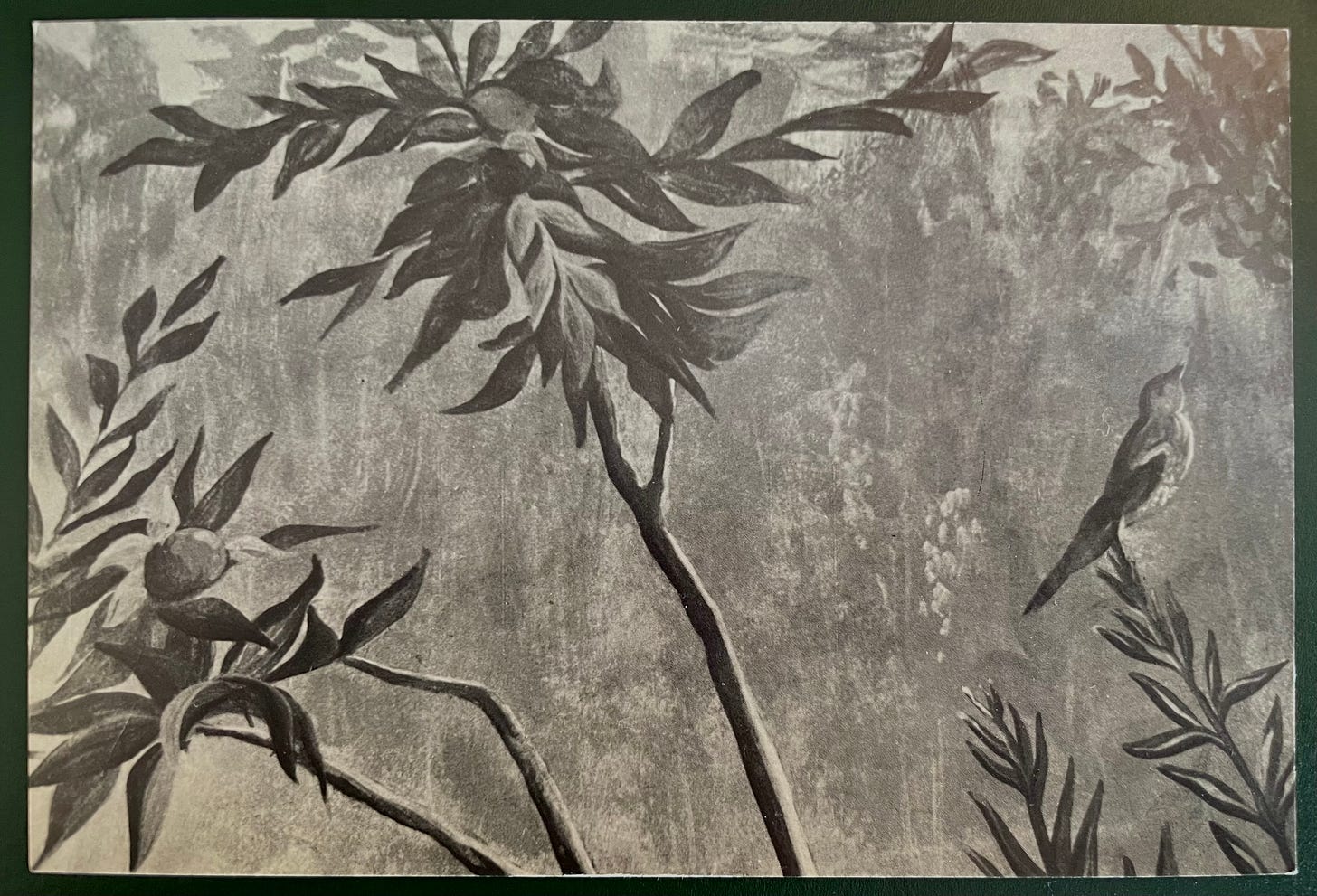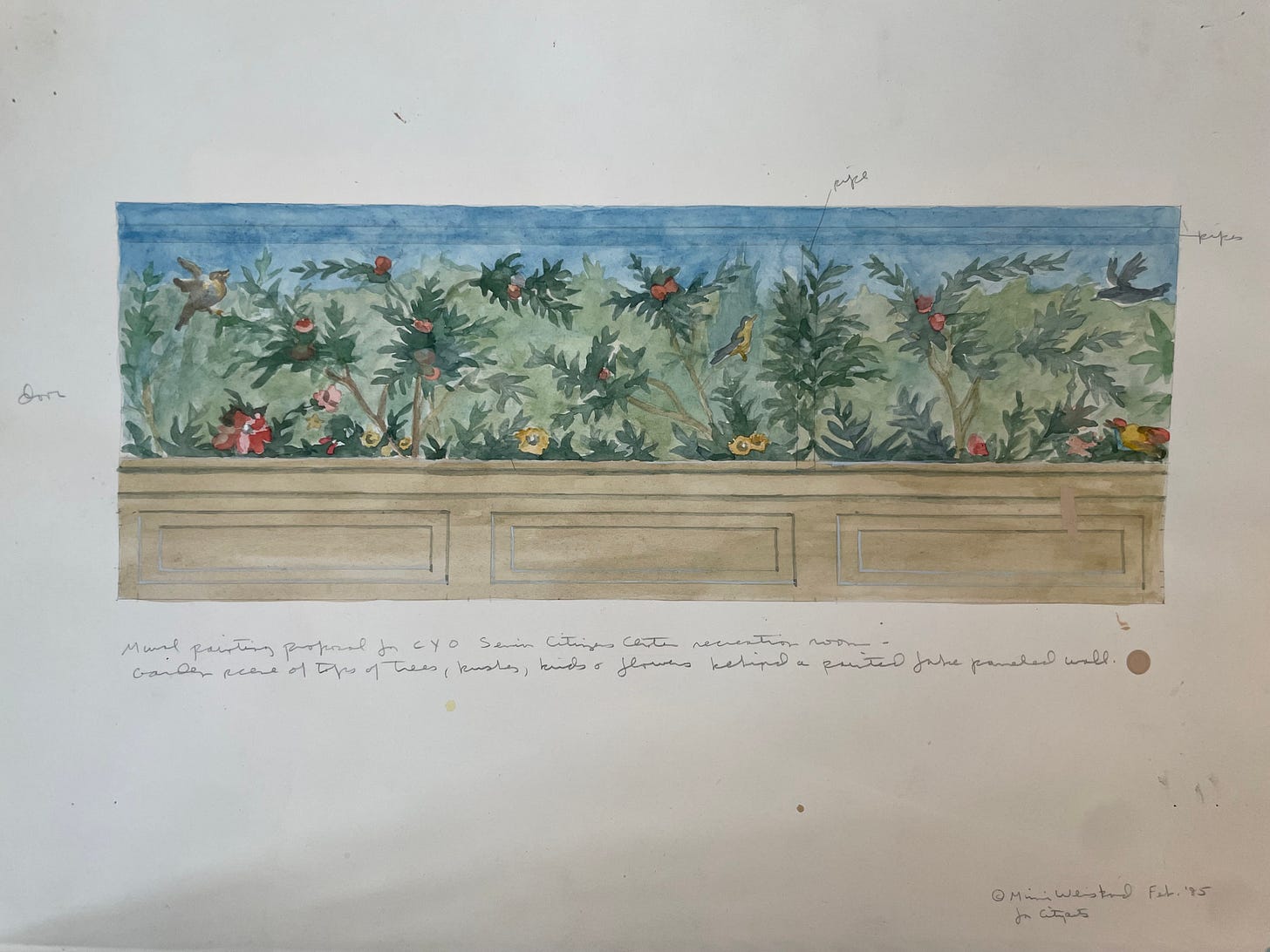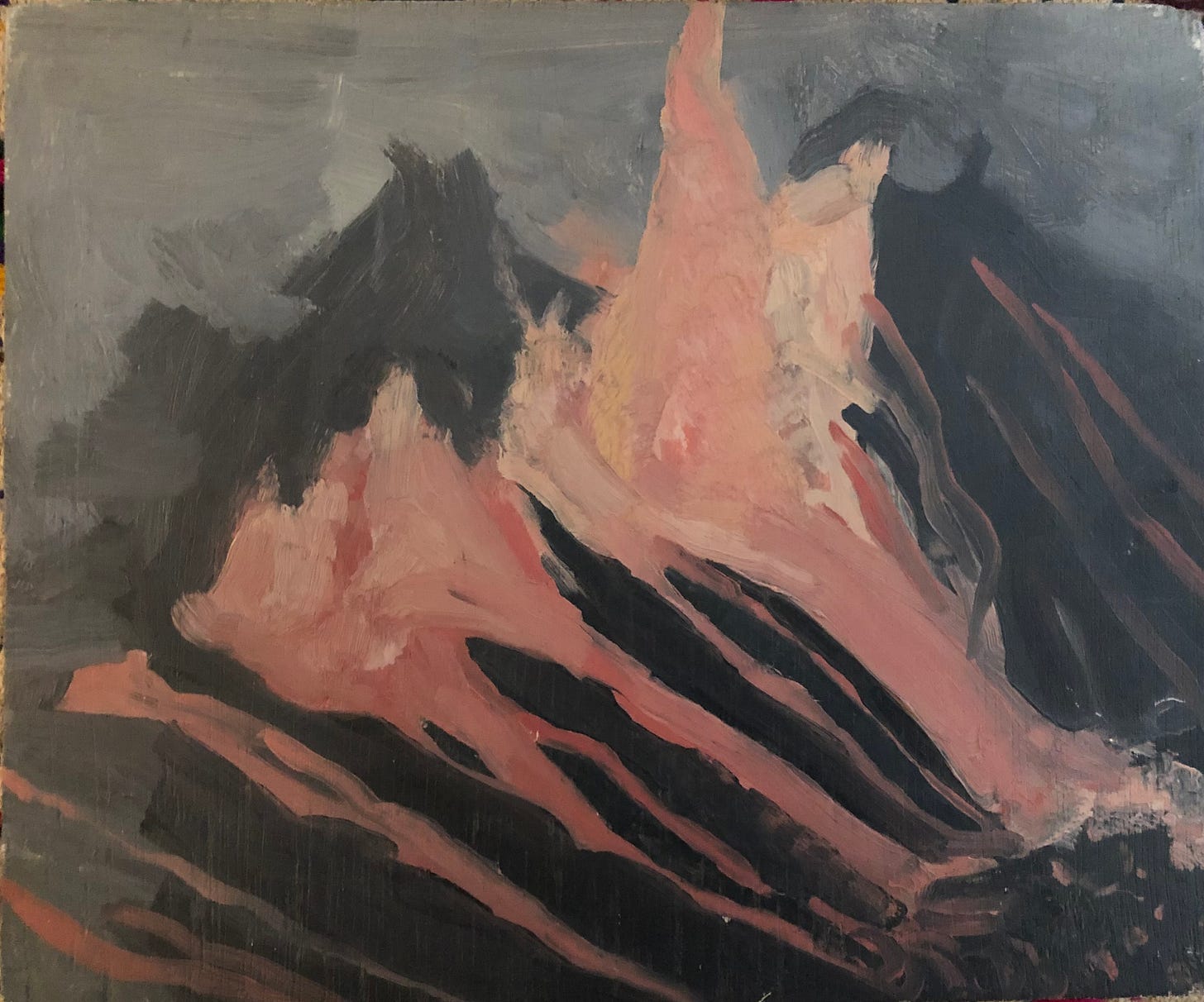Two Houses is a newsletter of stories about art, feminism, grief, and Time excavated from the Soho loft where I grew up. Posts are free and illustrated with the work of my long-divorced parents, the painters Mimi Weisbord and Lennart Anderson.
A scholarly “talk,” as my father would call it, about St. Mark’s Place is scheduled for the Bo Bartlett Center in Georgia on April 4th. The Lennart Anderson retrospective is on view there through April 12th, and this large street scene is in attendance. Douglas Geibel will present his research on Pompeian wall art and the myth-of-Medea influences he finds at work in this painting.
My father would have loved it. He loved being a puzzle to figure out.
One summer, when we were little kids, Orrin and I went to the same month-long session at Shire Village sleep-away camp, and he wrote us letters that made no sense. It wasn’t his elegant script that was the problem (though at first we thought so). When we finally saw him, he explained he’d alternated the words between our respective pages, so we’d have to place our letters side-by-side to make them whole. A fun code to crack, he defended, utterly blindsided to find this had landed so poorly on his kids.
(Learning of it later, Mimi was so disgusted, making matters only worse for us.)
That memory is interesting to consider in light of the task I’ve taken up in my writing. There’s a way in which my long-divorced parents were always completing each other’s sentences once I learned to carry them between their houses. For the little me, their persistent rancor was impossible to understand; they shared so much, two children perhaps the least of it (since “all roads lead to Rome”). Wanting to ease the tension (and wanting their attention), I carried their messages and studied them closely for how they fit together in order to make me whole. Mostly, this wasn’t conscious.
But the training is so hardwired that I may never let it go.
My parents visited Pompeii in late November of 1958, just two months after they arrived at the American Academy in Rome and less than four months after they married. I became aware of this recently, studying a postcard Mimi wrote to the painter Marcia Marcus. Marcia’s daughters have archived their mother’s correspondence with the Archives of American Art at the Smithsonian. They didn’t realize so much of Lennart’s was actually written by Mimi until I noted the handwriting and the fact that only Mimi typed. This misunderstanding was very poignant for me and, perhaps, for them, too.
They understand the strange invisibility that can cloak a woman artist.

Here is my only card from Pompeii – as they cost L40 apiece, which is too much. Pompeii is a great place to visit, but I wouldn’t want to live there. […] Went to cocktail party at Roberts, Thanksgiving night, and saw Pearlsteins and Stefanelli and Marisol. Have met some nice people from Yale and some poets and people so things are shaping up. Went to Stravinsky concert. It is now autumn. We are longing for N.Y. and a good old-fashioned pink and blue plastic Christmas (a joke).
Love, L & M
It’s rare for Mimi to sign this way, but she’d just married and was still figuring it all out. Often, my parents write on the same paper, mostly with Lennart adding to Mimi’s typed pages. On these occasions, it’s clear to me that my mother is sticking her letters under his nose to complete this act of sociability. My father will become so wedded to his studio at the Academy that he’ll lose three weeks to a hospital in Rome for a slipped disc (at age 31).
Mimi writes nothing about Pompeii on this card other than her quip referencing Vesuvius’s famous eruption (that buried the city and its residents). In general, my parents’ letters to Marcia Marcus shoot from the hip and lean toward gossip. They’re different from the ones written to family and lovely to have.
It was also thrilling to share with Marcia’s daughters their mother’s replies. I found Marcia’s letters in the loft, and likely I’ll mine them for future posts.
Mimi’s lone card from Pompeii is a provocative choice. The House of Mysteries holds frescos widely believed to depict a bride's initiation into a Bacchic cult in preparation for matrimony.1
I can’t recall exactly, but something about this visit to Pompeii with my father deeply disappointed her: perhaps Lennart’s lack of interest in exploring the grounds and gardens, or his frustration at not having close enough access to the wall art, or his not wanting to look at what she wanted to look at. (I’ve been to museums with my father.) I know she went back to Pompeii in the mid-70s full of satisfaction to see it on her own terms. When she got back, she was so exuberant she could not stop talking.
Eventually, she launched into a Vesuvius-inspired phase, painting eruptions on wood and some charcoal drawings with plumes of ash.
At the time that she likely painted this, they’d been separated about three years, and Lennart’s St Marks Place was nearing completion.
Pompeii’s influence on Lennart’s painting is beautifully subtle and full of tension and mystery.
Mimi clobbers it head-on.
I have much more to say about St Marks Place, but that’s a whole perplexing world in itself.
Consider, however, the feeding of the goats in the postcard from the House of Mysteries with the man and the dog in St. Mark’s Place. (I just did.) I wonder if they talked about it. He began St. Marks Place well before my mother moved out.
In 1985, Mimi won a CityArts grant to install a Pompeian mural at a senior center on Staten Island.

While cleaning out the loft, I came across her proposal for Roman Garden and a questionnaire she’d completed for a student ten years after this installation. The student visited each CityArts mural and drafted questions for their artists.
The exchange is a great find. Lennart is on YouTube and across the Web. It’s rare to find interviews with my mother.
First, here’s the paragraph she wrote for her mural proposal:
I have used the classical influence of the handsome Ionic exterior of this building to create a mural in the recreation room reminiscent of Roman fresco painting. It depticts a part of a garden behind a wainscotted half wall. This should create the right atmosphere for dancing, card playing and other recreational activities. The top part of the painting is a garden scene with birds, flower and treetops growing out behind a “trompe l’oeil” or “fake” wall of wainscoting. The wainscoting is as high as the existing molding on the wall to the right and could continue on all three walls. On the mirrored wall, the wainscoting is higher and includes fake panel framing in order to incorporate contributions of 9” x 12” paintings by members of the center. These paintings could be landscapes, still lifes, or scenes of Staten Island, and can be painted on the wall (at eye level) or in the art class, and attached to the wall when completed. They would fit in well, I believe, with the concept of the mural and would be a permanent art exhibition of interest to all the members of the center.

She’d moved on from her large City Walls proposals. She is not painting to be seen for her work. She is painting in service to the seniors of Staten Island.
“How did you and your assistants decide on the theme chosen for the mural?,” the student asks.
I chose the theme because of the classical architecture of the building, because I love Pompeian painting and I believe there was a large Italian population at the center. The art teacher and I liked the idea of her class painting themes from Staten Island. As for assistants - I had none except on an informal basis - for priming and spackling and underpainting.
“Was the theme different from the ones other CityArts artists were doing at the time? How?”
I don’t know what the other artists were doing at that time - I had no contact with other artists - but - I can’t imagine anyone else would have been interested in something that romantic. I should add that another reason I chose this was to give PLEASURE to the people who used the center and thought it would be a wonderful backdrop for the card-playing, dancing, socializing, etc. I loved it that a photographer from a local newspaper did photograph them dancing in front of it.
“What special message do you think your mural conveys?”
I wasn’t trying to convey a message - I was trying to convey an atmosphere - bringing life and growth indoors to make the room less claustrophobic. And I liked and was challenged by the idea of incorporating the member’s painting into mine.
This is interesting to read in light of her earlier proposal to augment Richard Serra’s Tilted Arc, another proposal to combine the work of different artists (hers and his), another opportunity to improve a claustrophobic atmosphere (as created by a looming 12-foot rusted steel wall.)
“What do you get out of working with CityArts rather than working as an independent artist?”
I like being involved with public art - and I like the challenge of figuring out how to deal with a site someone else chooses. I also like the scale of working with part of a room - I spent three years in Italy looking at mural painting - I think painting should be on the walls of rooms rather [than] on canvases.
(Lennart painted a bacchanal on his bedroom wall in Brooklyn. At his wake, Mimi returned to the house, saw it, and stunned me when she murmured, “We’d always talked about doing that in there.”)
“What kind of responses have you received from community members about your work?”
I felt that some of the community members perhaps had trouble dealing with the idea of a middle-aged woman doing that kind of heavy labor (it was heavy labor!). However, it was very well received. At the end, they all gave me a lovely party for the dedication - over a hundred people attended and brought food. There was tremendous love and warmth.
Years beyond her last visit to Pompeii, Vesuvius is no longer raging.
Pappalardo, Umberto (2009). The Splendor of Roman Wall Painting. Los Angeles, California: Getty Publications. pp. 49–50.






I can picture you and Orrin trying to figure out that sneaky letter at camp… rather brilliant. Also, “Pompeii is a great place to visit, but I wouldn’t want to live there” gave me a chuckle this morning. I’m seeing it as a title for….. something?!
Agree with all about how well it all reads. I am obsessed with Mary Gabriel’s Ninth Street Women but this could be the next one to illustrate the love of a child’s perspective after their parent artists are gone. I love reading these!